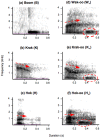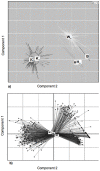Campbell's monkeys use affixation to alter call meaning - PubMed (original) (raw)
Campbell's monkeys use affixation to alter call meaning
Karim Ouattara et al. PLoS One. 2009.
Abstract
Human language has evolved on a biological substrate with phylogenetic roots deep in the primate lineage. Here, we describe a functional analogy to a common morphological process in human speech, affixation, in the alarm calls of free-ranging adult Campbell's monkeys (Cercopithecus campbelli campbelli). We found that male alarm calls are composed of an acoustically variable stem, which can be followed by an acoustically invariable suffix. Using long-term observations and predator simulation experiments, we show that suffixation in this species functions to broaden the calls' meaning by transforming a highly specific eagle alarm to a general arboreal disturbance call or by transforming a highly specific leopard alarm call to a general alert call. We concluded that, when referring to specific external events, non-human primates can generate meaningful acoustic variation during call production that is functionally equivalent to suffixation in human language.
Conflict of interest statement
Competing Interests: The authors have declared that no competing interests exist.
Figures
Figure 1. Spectrographic illustrations of the different loud call types produced by male Campbell's monkeys in different contexts.
(a) ‘boom call’, a low-pitched loud call produced by the vocal sac with no frequency modulation, (b) ‘krak’ call [K], a single loud tonal utterance of ø = 0.176s duration, with a decreasing main frequency band starting at about 2.2 kHz; (c) ‘hok’ call [H], a single loud tonal utterance of ø = 0.070s with no frequency modulation starting at about 1.0 kHz); (d) ‘wak-oo’ call [W+], a suffixed loud tonal utterances of 0.330s consisting of a call stem with an increasing main frequency band rising from about 1.0 to 1.3 kHz, followed by a compulsory ‘oo’ suffix (e) ‘krak-oo’ call [K+], a ‘krak’ call followed by the ‘oo’ suffix; (f) ‘hok-oo’ [H+], a ‘hok’ call followed by the ‘oo’ suffix.
Figure 2. Results of the principal component analysis.
(a) call stem clustering (b) male clustering. Call names (B, K, K+, W+, H and H+) are indicated at the corresponding position. M1, M2, M3 = males 1–3.
Similar articles
- Interspecies semantic communication in two forest primates.
Zuberbühler K. Zuberbühler K. Proc Biol Sci. 2000 Apr 7;267(1444):713-8. doi: 10.1098/rspb.2000.1061. Proc Biol Sci. 2000. PMID: 10821618 Free PMC article. - Suffixation influences receivers' behaviour in non-human primates.
Coye C, Ouattara K, Zuberbühler K, Lemasson A. Coye C, et al. Proc Biol Sci. 2015 May 22;282(1807):20150265. doi: 10.1098/rspb.2015.0265. Proc Biol Sci. 2015. PMID: 25925101 Free PMC article. - Acoustic variability and social significance of calls in female Campbell's monkeys (Cercopithecus campbelli campbelli).
Lemasson A, Hausberger M. Lemasson A, et al. J Acoust Soc Am. 2011 May;129(5):3341-52. doi: 10.1121/1.3569704. J Acoust Soc Am. 2011. PMID: 21568434 - Hornbills can distinguish between primate alarm calls.
Rainey HJ, Zuberbühler K, Slater PJ. Rainey HJ, et al. Proc Biol Sci. 2004 Apr 7;271(1540):755-9. doi: 10.1098/rspb.2003.2619. Proc Biol Sci. 2004. PMID: 15209110 Free PMC article. - Socially meaningful vocal plasticity in adult Campbell's monkeys (Cercopithecus campbelli).
Lemasson A, Hausberger M, Zuberbühler K. Lemasson A, et al. J Comp Psychol. 2005 May;119(2):220-9. doi: 10.1037/0735-7036.119.2.220. J Comp Psychol. 2005. PMID: 15982165
Cited by
- Vocal repertoire of free-ranging adult golden snub-nosed monkeys (Rhinopithecus roxellana).
Fan P, Liu X, Liu R, Li F, Huang T, Wu F, Yao H, Liu D. Fan P, et al. Am J Primatol. 2018 Jun;80(6):e22869. doi: 10.1002/ajp.22869. Epub 2018 May 16. Am J Primatol. 2018. PMID: 29767431 Free PMC article. - Copying hierarchical leaders' voices? Acoustic plasticity in female Japanese macaques.
Lemasson A, Jubin R, Masataka N, Arlet M. Lemasson A, et al. Sci Rep. 2016 Feb 16;6:21289. doi: 10.1038/srep21289. Sci Rep. 2016. PMID: 26880673 Free PMC article. - Call combination production is linked to the social environment in Western Australian magpies (Gymnorhina tibicen dorsalis).
Walsh SL, Townsend SW, Engesser S, Ridley AR. Walsh SL, et al. Philos Trans R Soc Lond B Biol Sci. 2024 Jul 8;379(1905):20230198. doi: 10.1098/rstb.2023.0198. Epub 2024 May 20. Philos Trans R Soc Lond B Biol Sci. 2024. PMID: 38768205 Free PMC article. - Wild gelada monkeys detect emotional and prosocial cues in vocal exchanges during aggression.
Pedruzzi L, Francesconi M, Galotti A, Bogale BA, Palagi E, Lemasson A. Pedruzzi L, et al. PLoS One. 2025 May 14;20(5):e0323295. doi: 10.1371/journal.pone.0323295. eCollection 2025. PLoS One. 2025. PMID: 40367038 Free PMC article. - Social learning of vocal structure in a nonhuman primate?
Lemasson A, Ouattara K, Petit EJ, Zuberbühler K. Lemasson A, et al. BMC Evol Biol. 2011 Dec 16;11:362. doi: 10.1186/1471-2148-11-362. BMC Evol Biol. 2011. PMID: 22177339 Free PMC article.
References
- Hauser MD, Chomsky N, Fitch WT. The Faculty of Language: What Is It, Who Has It, and How Did It Evolve? Science. 2002;298:1569–1579. - PubMed
- Oller DK, Griebel U, editors. Cambridge: The MIT Press; 2008. Evolution of communicative flexibility: complexity, creativity, and adaptability in human and animal communication.352
- Snowdon CT, Hausberger M, editors. Social influences on vocal development Cambridge: Cambridge University Press. 1997. 362
- Masataka N. Cambridge: Cambridge University Press; 2003. The onset of language.296
- Chomsky N. Knowledge of language: its elements and origins. Print Trans R Soc London. 1981;295:223–234.
Publication types
MeSH terms
LinkOut - more resources
Full Text Sources
Miscellaneous

